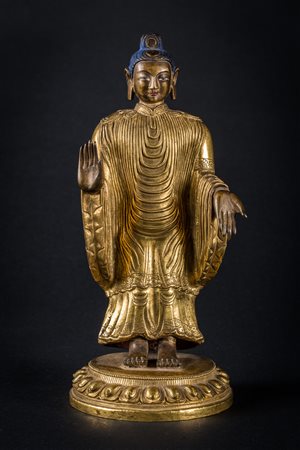 Capitolium Art - Via Carlo Cattaneo 55, 25121 Brescia
Capitolium Art - Via Carlo Cattaneo 55, 25121 Brescia
ASTA 217 - FINE CHINESE, ISLAMIC & ASIAN ART 2A TORNATA
Thursday 15 June 2017 hours 14:00 (UTC +01:00)
Arte Cinese Statua raffigurante Udayana Buddha Cina, dinastia Qing, periodo...
Arte Cinese Statua raffigurante Udayana Buddha
Cina, dinastia Qing, periodo Qianlong, 1736 - 1795. -. Cm 11,00 x 26,50. Grande scultura realizzata in tecnica mista, parzialmente in fusione (testa, mani, piedi) e parzialmente a sbalzo repoussé (le vesti). Il Buddha storico Sakyamuni é qui rappresentato in posizione stante (samapafa), su una base a fiore di loto singolo con i palmi delle mani rivolti verso l'esterno: la sinistra nel gesto di esaudimento dei desideri varadamudra e la destra nel gesto di incoraggiamento abhayamudra. Veste una lunga tunica a maniche ampie caratterizzata da intricati giochi di panneggio concentrici e decori floreali cesellati sui bordi, nello stile tipico di epoca Qianlong. Sullo ieratico volto sono presenti inoltre cospicue tracce policrome, mentre sulla capigliatura, arricchita da un pigmento blu, è presente un doppio disco, probabilmente ad indicare un riferimento solare.
Questa non comune rappresentazione é denominata Udayana (semi mitica zona situata nell'odierna valle del Swat, Pakistan) o sandalwood Buddha, a causa di una leggendaria scultura in legno di sandalo, ormai persa, che dalla Cina venne acquistata dal regnante dell'Udayana.
Iconograficamente tale rappresentazione è conosciuta in Cina fin dal V secolo d.C. e sembra, in accordo con cronache di viaggio cinesi, che sia stata importata direttamente dall'india intorno al I secolo d. C.
Evidente inoltre l'influenza dell'arte gandharica nella resa complessiva della figura.
Provenienza: Collezione privata piemontese, acquistata prima del 1960.
Arte Cinese Udayana Buddha
China, Qing dynasty, Qianlong period, 1736 - 1795. . Cm 11,00 x 26,50. Big sculpture produced with mixed techniques: partially cast (head, hands, feet) and partially embossed (the robes). The historical Buddha Sakyamuni is represented standing (samapafa) on a single lotus flower base, with the palms of the hands facing outwards: the left performing the gesture of gift giving, varadamudra, and the right performing the gesture of reassurance, abhayamudra. He wears a long robe with wide sleeves, characterized by intricate draping and chiseled floral decors on the edges, in the style characteristic of the Qianlong period. On the peaceful face are polychrome traces, while over the hair, enriched by a blue pigment, is a double disc, probably a reference to the sun.
This rare kind of representation is known as Udyana (semi-mythical region of present day’s Swat District, Pakistan) or sandalwood Buddha, because of a legendary sandalwood sculpture, now lost, which was bought in China by the ruler of Udyana. Such representation has been known in China since the 5th century and, according to Chinese travel chronicles, it appears that it was imported directly from India around the 1st century.
The ghandaric influence is clear in the general appearance of the figure.
Provenance: private collection Piedmont, acquired before 1960









